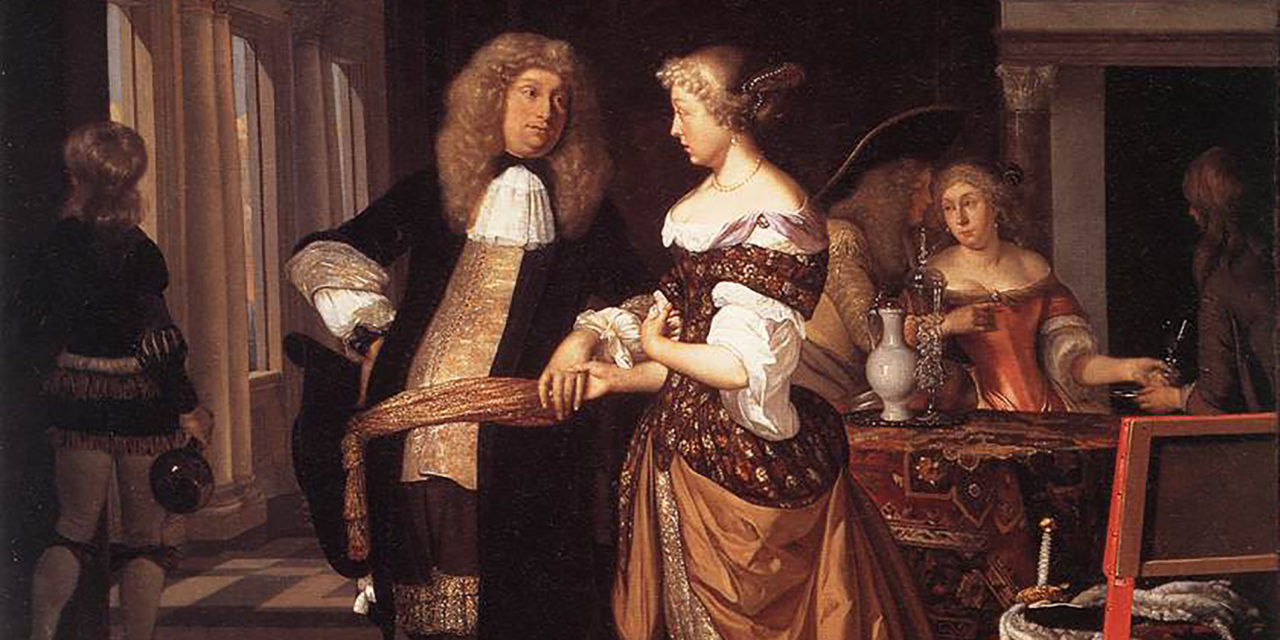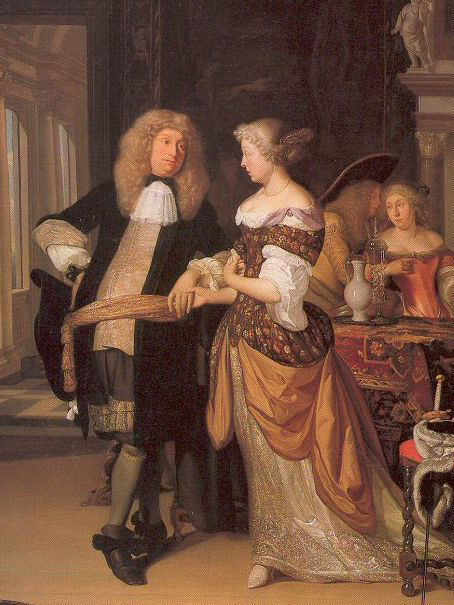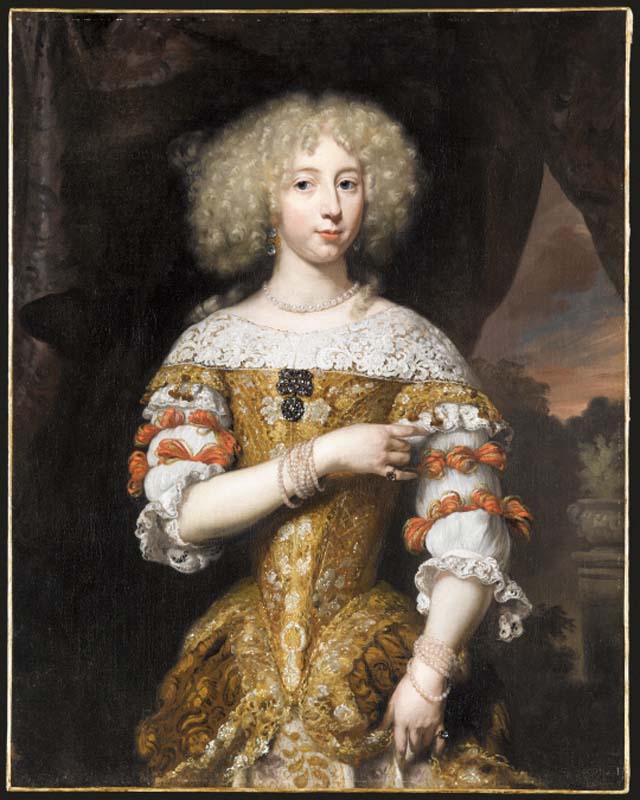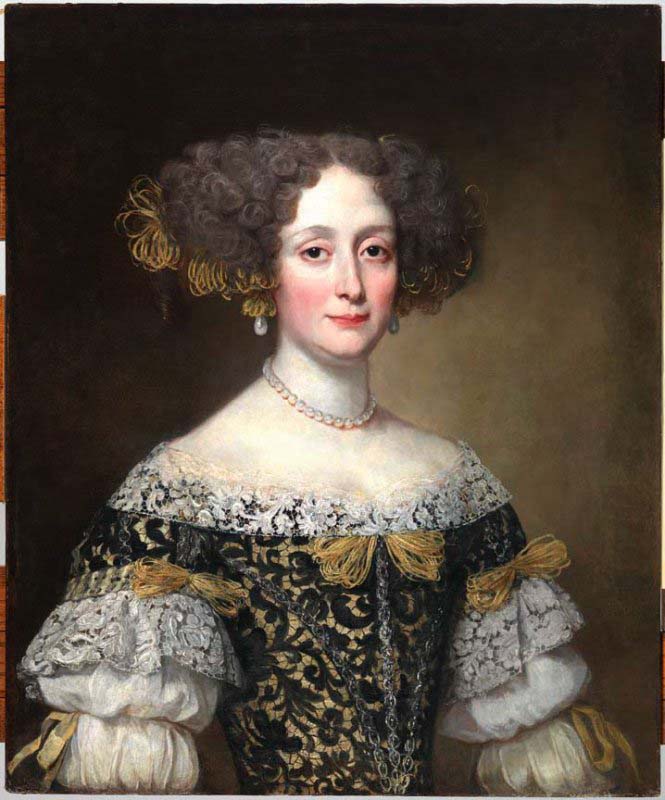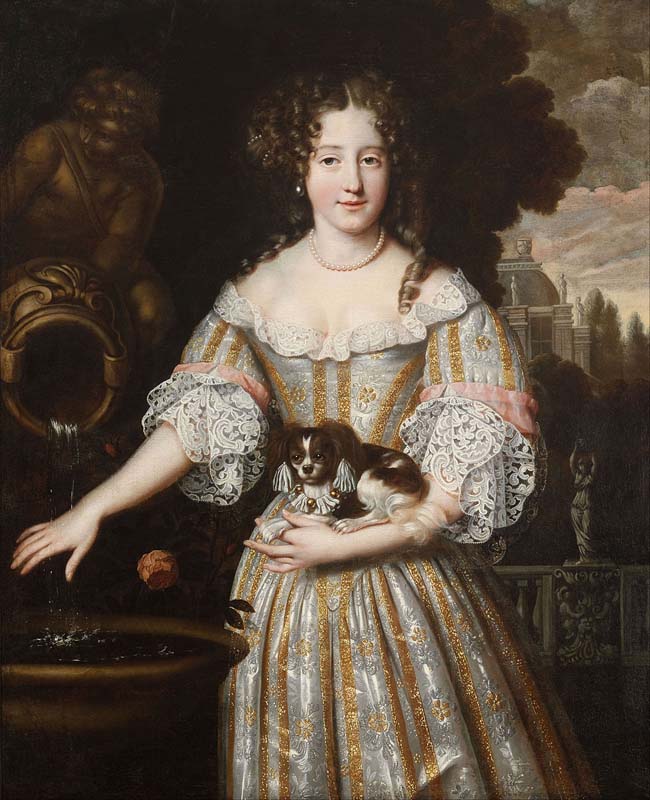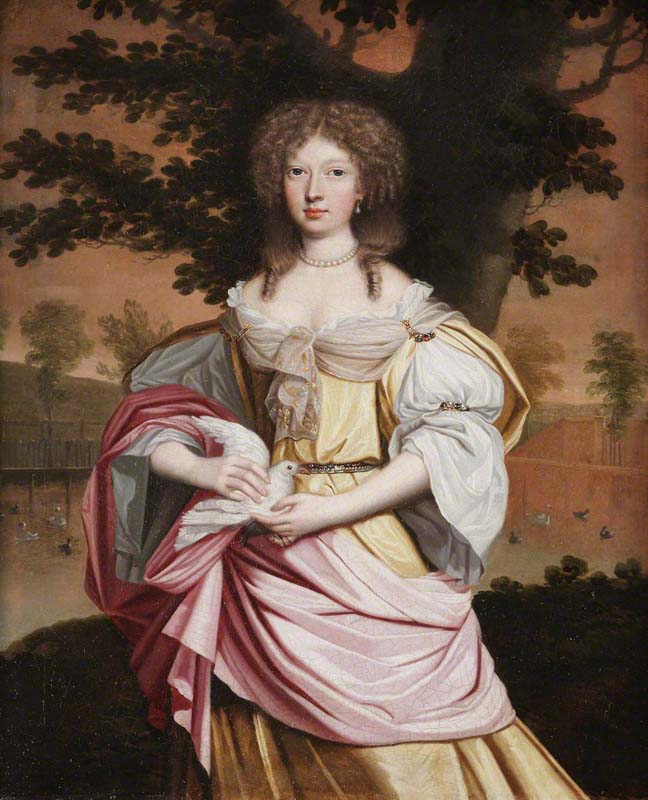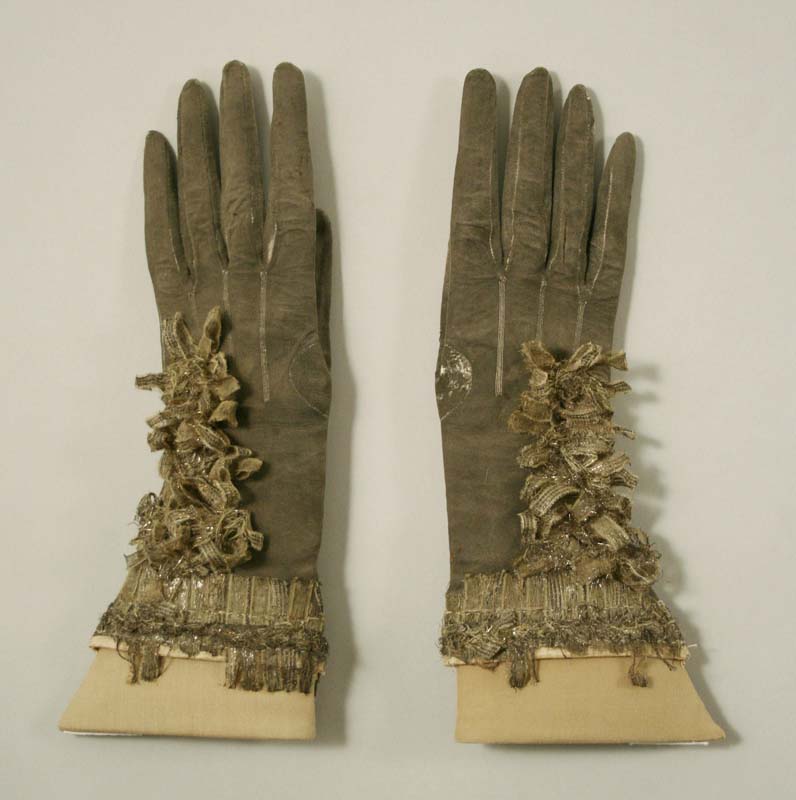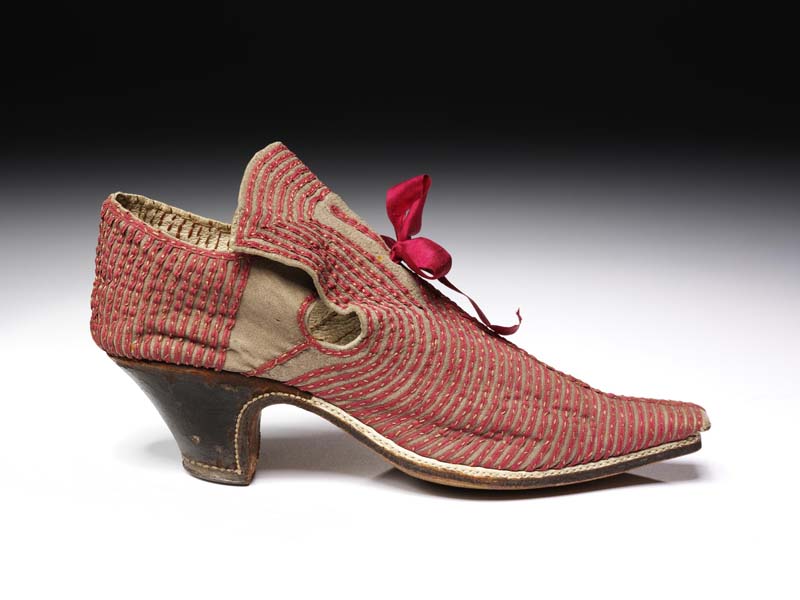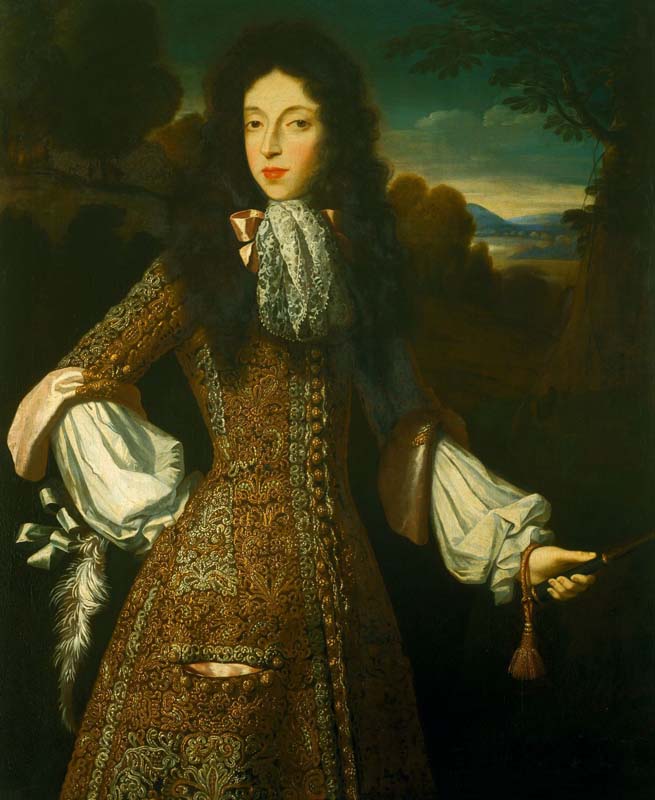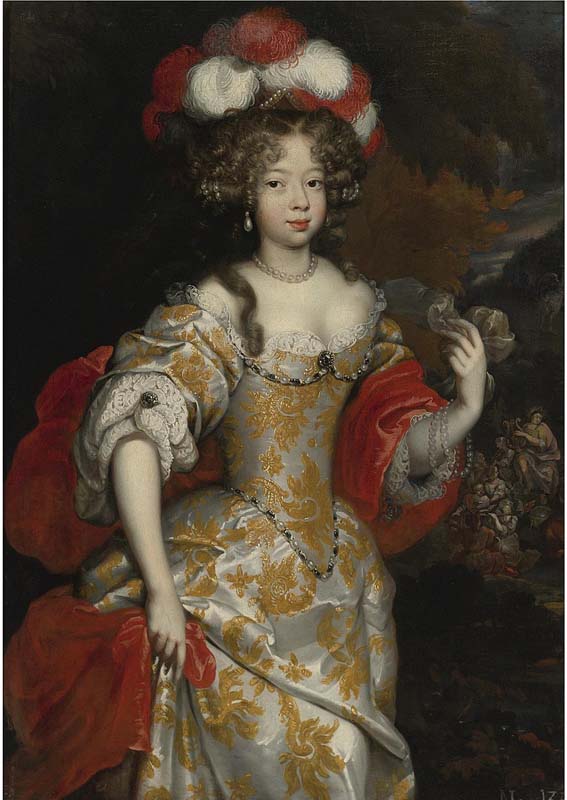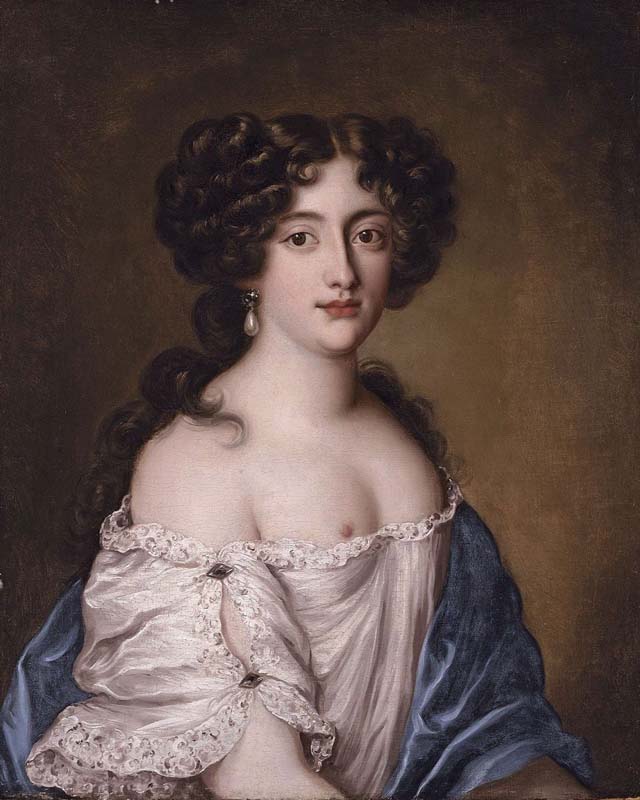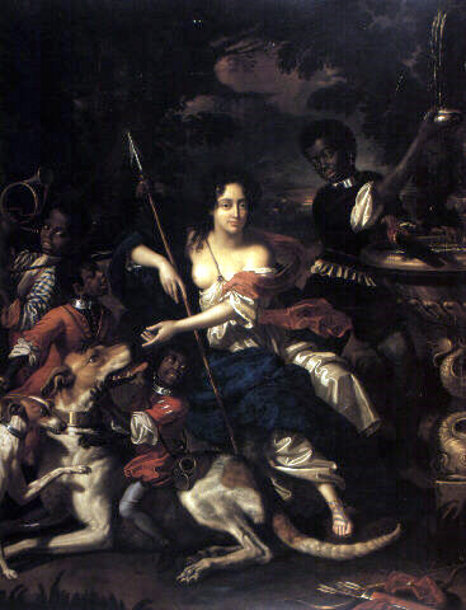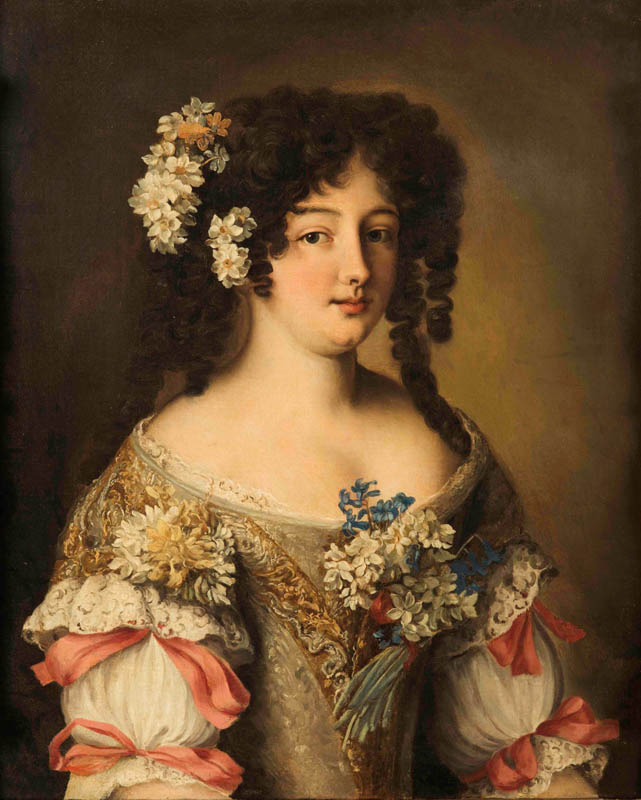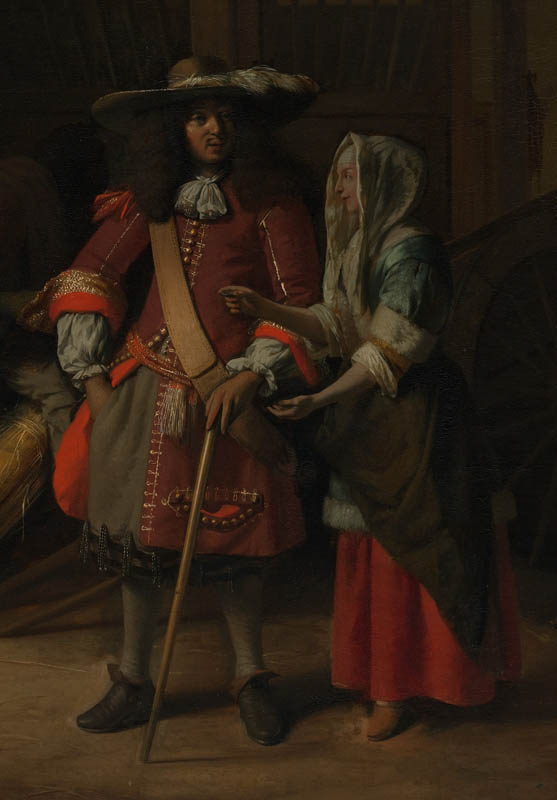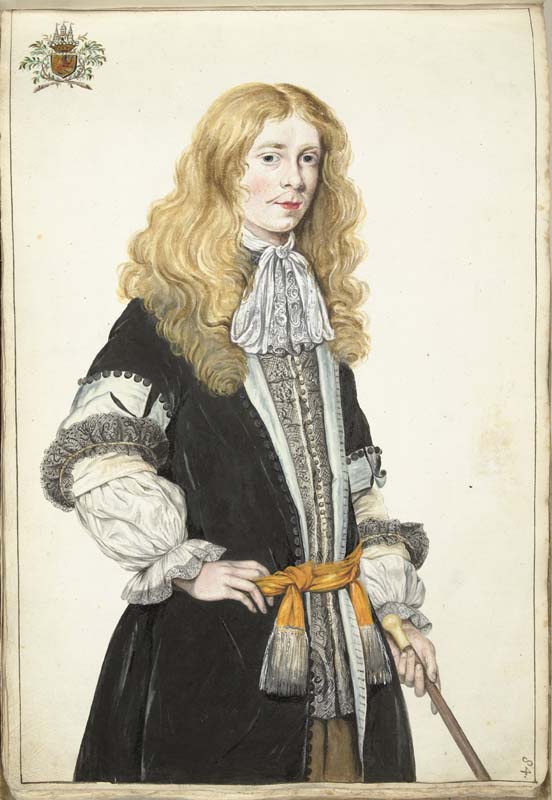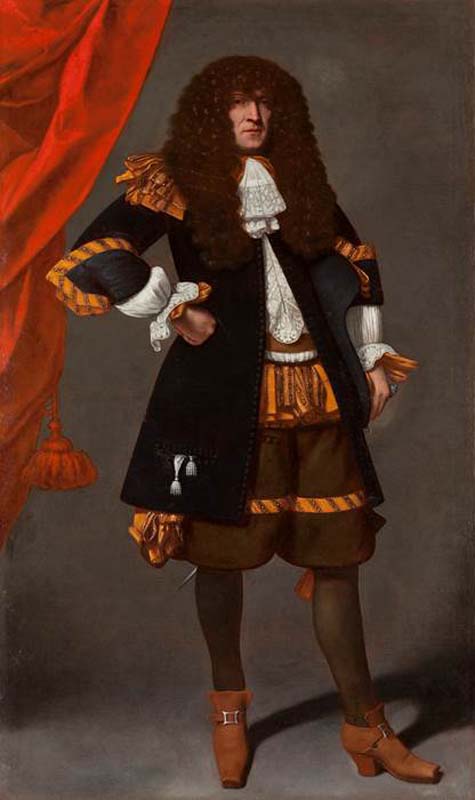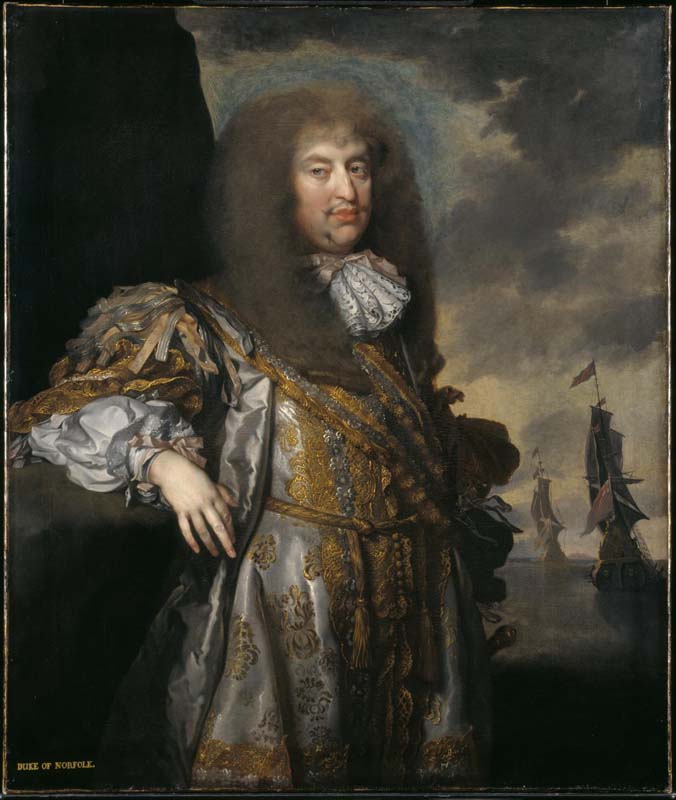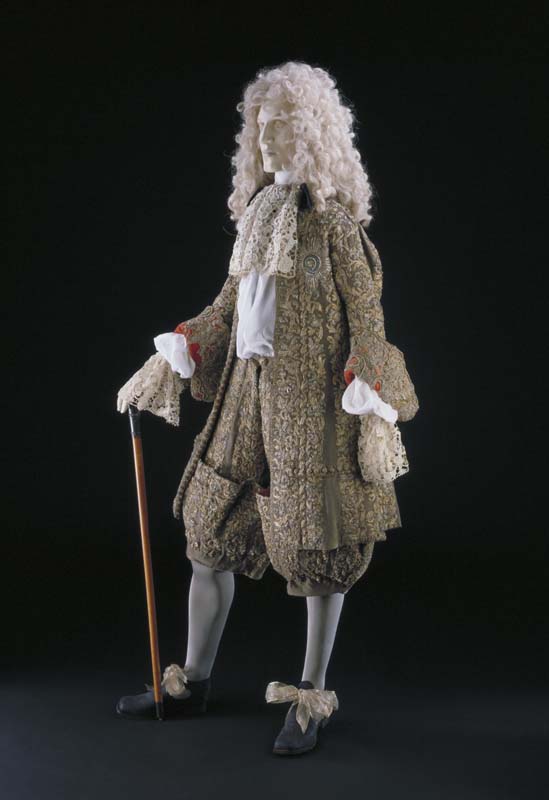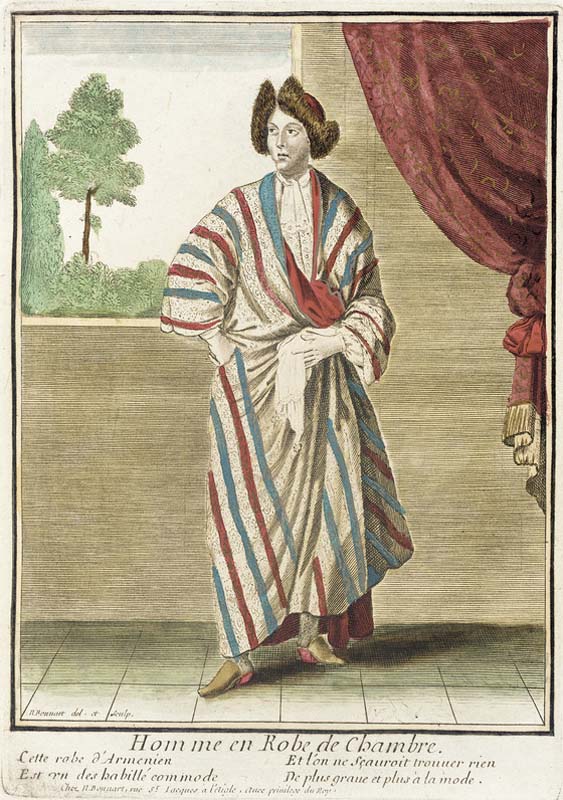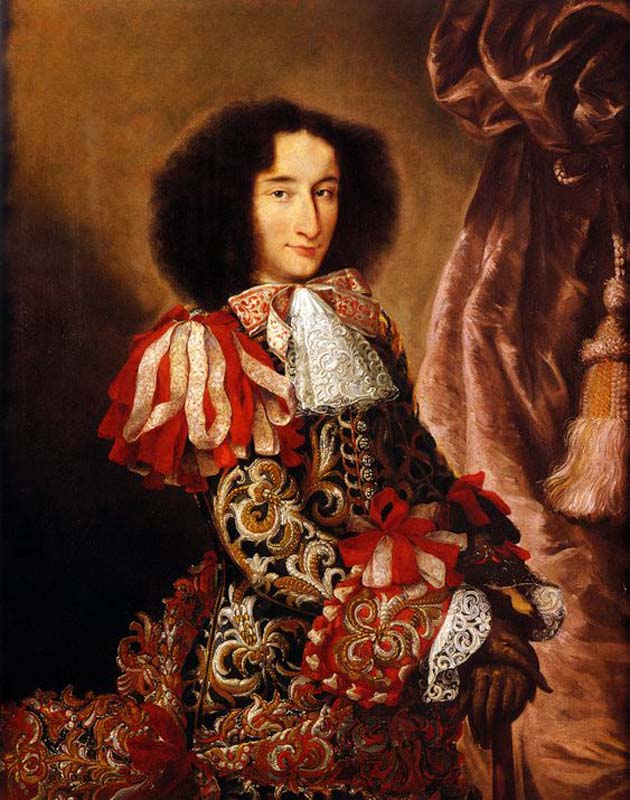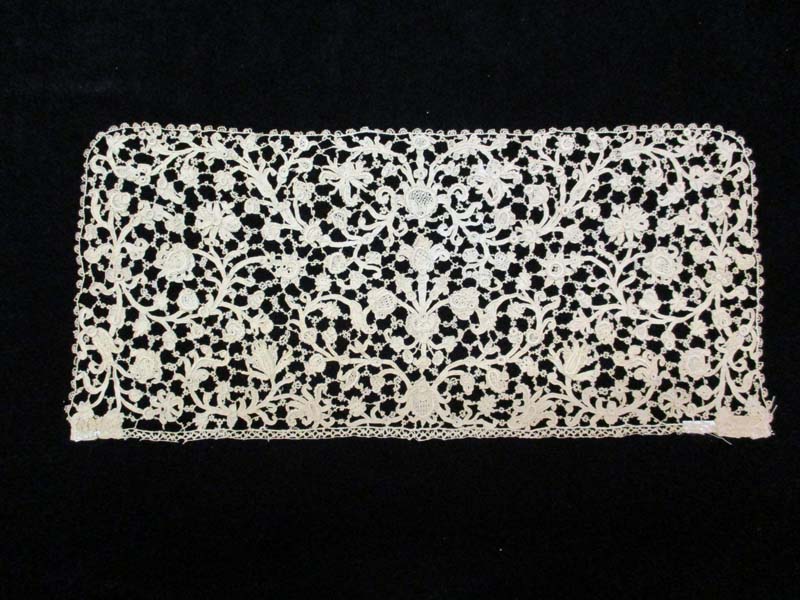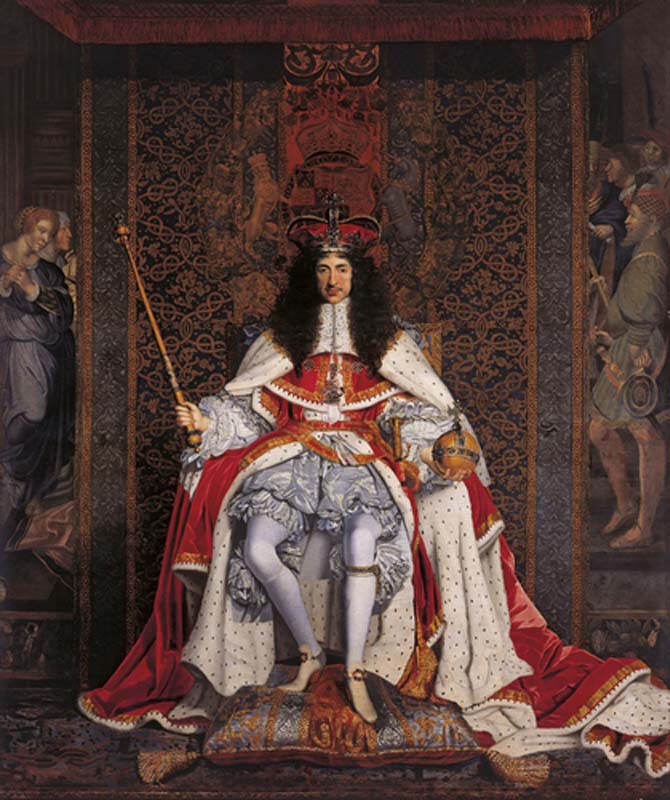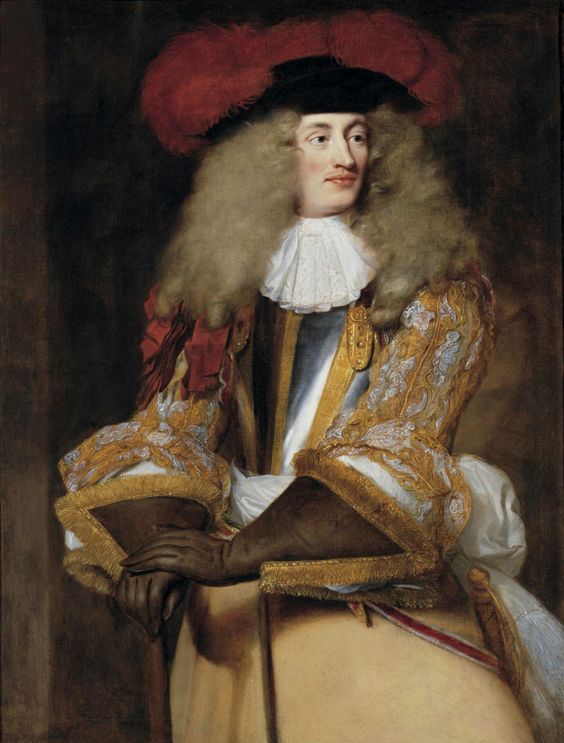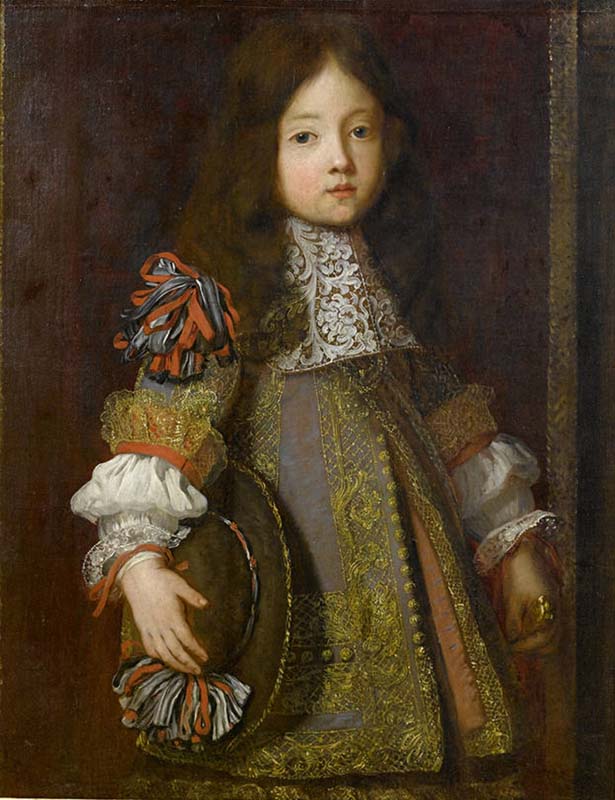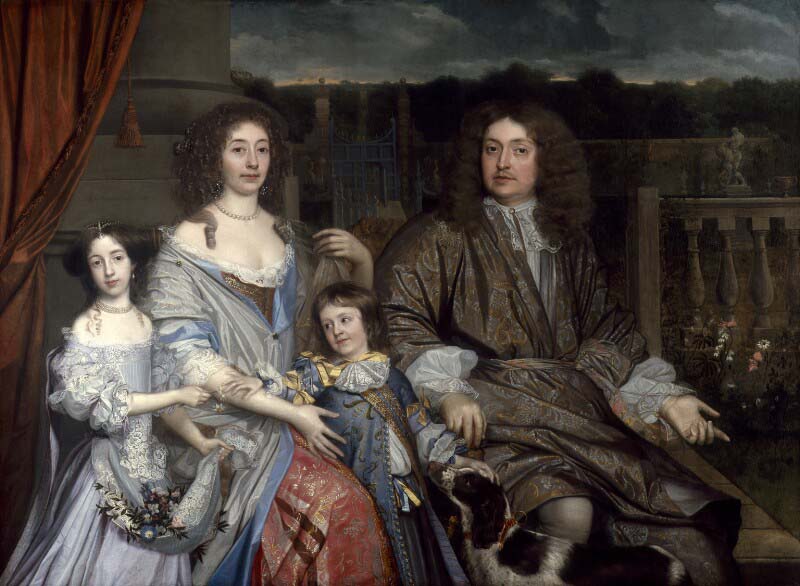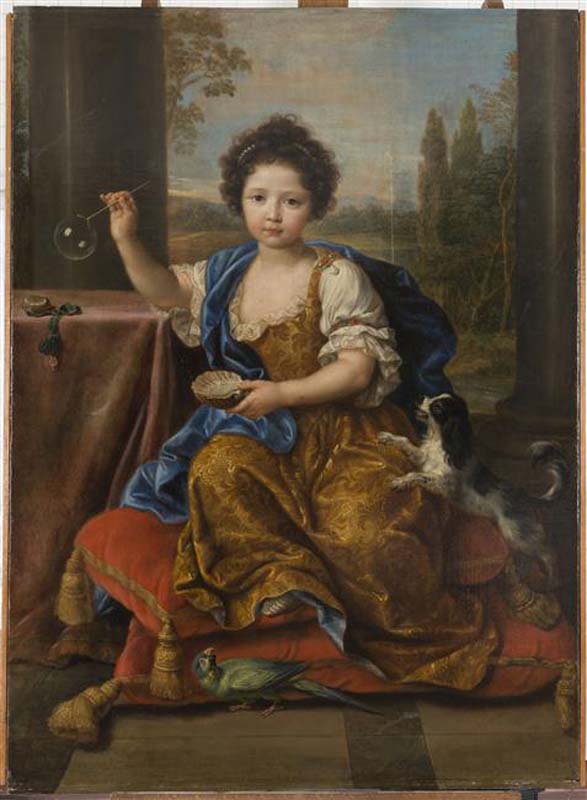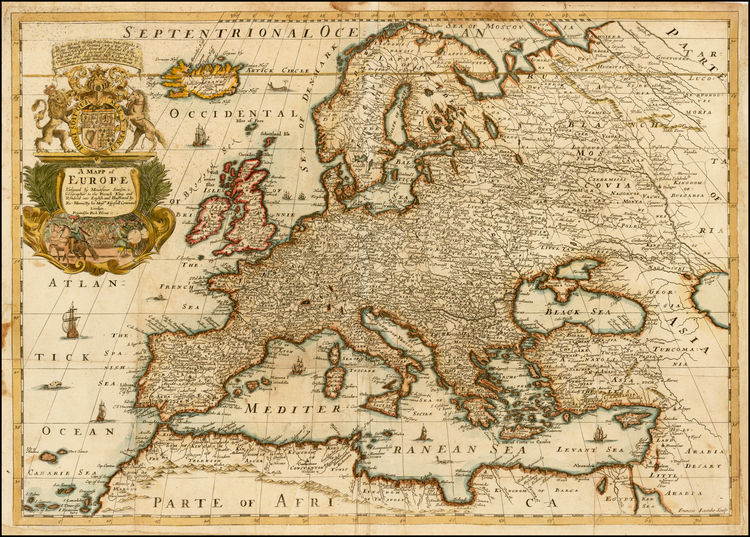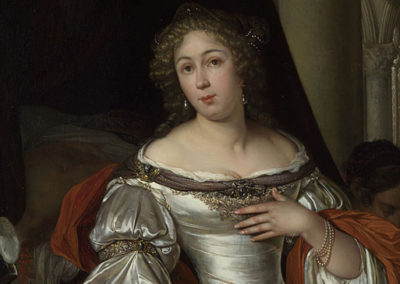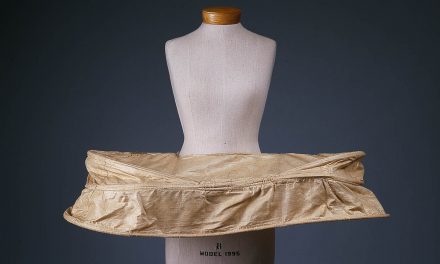OVERVIEW
1670s womenswear saw the advent of the looped-up overskirt along with a growing enthusiasm for brocade fabrics. Men of the period uniformly adopted the long collarless coat (known as a justaucorps) and full curly wigs became the dominant hairstyle.
Womenswear
The 1670s in womenswear saw the broader adoption of brocade fabrics and a trend for looping the skirt up into a bustle, revealing a contrasting petticoat. As Valerie Cumming describes in A Visual History of Costume: The Seventeenth Century (1984): “The long, trained skirt was, by now, invariably looped back into a low bustle, revealing the petticoats” (110). Eglon van der Neer’s Elegant Couple in an Interior (Fig. 1) gives a clear view of these fashions. The woman in the foreground wears a brown brocade bodice that comes down to a rounded point in the front, with a matching skirt pinned and looped back to reveal its lining and the silver petticoat trimmed in metallic lace beneath. Her bodice sleeves are extremely short, leaving ample chemise sleeve visible. A length of lace edges her bodice, as well as a pinned purple scarf; her bodice sleeves also have lace along the edges. She wears a single stranded pearl necklace, as well as pearl earrings and strands of pearls in her hair. In contrast to the plain leather flat-toed shoes of her husband, her high-heeled shoes come to a point and seem to sparkle with metallic lace.
Princess Teresa Pamphilj Cybo (Fig. 2) models another version of the fashionable silhouette of the 1670s. Her bodice and skirt are trimmed with silver-gilt lace and her petticoat is covered in silver and silver-gilt embroidery. Her bodice, sleeves and looped-up skirt are adorned with red ribbon loops that match her petticoat and her hair is filled with red ribbons. This accords with Millia Davenport’s description of hairstyles of the 1670s: that curls “hang on the shoulders in the 70s and are heavily decorated with ribbon knots.” Nicolaes Maes portrait of an unknown woman (Fig. 3) shows the dangling curls resting on the shoulders mentioned by Davenport. Anna Caffarelli Minuttiiba (Fig. 4) lacks the long curls but again has the masses of ribbon loops.
These portraits (Figs. 2-4) attest to the popularity of patterned fabrics (whether brocade, embroidery or lace), short sleeves, lace trim, ribbon loops and pearl necklaces. We also see that chemise sleeves in the period are often cinched in at several points by ribbons and then bloused to create a tiered effect.
Fig. 1 - Eglon van der Neer (Dutch, 1634-1703). Elegant Couple in an Interior, 1678. Oil on canvas; 85.5 x 70.1 cm (33.7 x 27.6 in). Hamburg: Private Collection. Source: RKD - Netherlands Institute for Art History
Fig. 2 - Jacob Ferdinand Voet (Flemish, 1639-89). Portrait of Princess Teresa Pamphilj Cybo, ca. 1673. Oil on canvas; 223 x 161 cm (87 3/4 x 63 3/8 in). Private Collection. Source: Sothebys
Fig. 3 - Nicolaes Maes (Dutch, 1634-93). Portrait of a Woman, 17th century. Oil on canvas. Toulouse: Musée des Augustins. Source: RMN
Fig. 4 - Jacob-Ferdinand Voet (Flemish, 1639-1700). Anna Caffarelli Minuttiba, late 17th century. Oil on canvas; 77.5 x 63.8 cm (30 1/2 x 25 1/8 in). San Francisco: Fine Arts Museum San Francisco, 39.2.1. Museum purchase, Gift of M.H. de Young Endowment Fund. Source: FAMSF
Fig. 5 - Henri Gascar (French, 1635-1701). Louise de Keroualle, Duchess of Portsmouth, ca. 1670. Oil on canvas; 121.5 x 98.3 cm. Auckland: Auckland Art Gallery, 1952/17/1. Auckland Art Gallery Toi o Tāmaki, gifted in memory of Mr and Mrs Joseph James Craig of Auckland by their children, 1952. Source: Auckland Art Gallery
Louise de Kéroualle (Fig. 5), Duchess of Portsmouth and mistress to Charles II, carries a small King Charles spaniel as a not-so-subtle hint to their relationship. Her hairstyle caused a sensation when Kéroualle,
“a member of the French retinue that accompanied Henrietta, Duchess of Orleans, on her visit to her brother, Charles II, in 1670. It parallels the bulkiness of the male wig, with the hair arranged in tight bunches of curls on either side of a flat central parting, with two or three long curls hanging over the shoulders.” (Ashelford 99)
Mary Wilbraham (Fig. 6) has adopted Kéroualle’s hairstyle but is dressed in a quasi-classical drapery style. Notable is that her dress is belted at the natural waist, when waistlines in the 1670s tended to be much lower. Louise de Kéroualle was also portrayed in this drapery fashion by the still popular Peter Lely (Fig. 7). Her loose gown isn’t belted at all, instead it’s only loosely clasped down the front.
Fig. 6 - John Michael Wright (British, 1617-94). Mary Wilbraham (1661–1737), Countess Bradford, ca. 1673-77. Oil on canvas; 62 x 50 cm. Wrexham: National Trust, Chirk Castle, 1171146. Source: ArtUK
Fig. 7 - Sir Peter Lely (Dutch, 1618-80). Portrait of Louise de Keroualle, Duchess of Portsmouth, ca. 1671-74. Oil on canvas; 125.1 x 101.6 cm (49 1/4 x 40 in). Lose Angeles: The Getty, 78.PA.223. Source: Getty
Fig. 8 - Godefridus Schalcken (Dutch, 1643-1706). Portrait of Elisabeth Tallyarde, 1679. Oil on oak panel. Middelburg: Zeeuws Museum. Source: Pinterest
Fig. 9 - Artist unknown (French). Presumed portrait of the Princess of the Ursins, ca. 1670. Oil on canvas; 65 x 53 cm. Chantilly: Condé Museum, PE339. Source: L'agence Photo
Elisabeth Tallyarde (Fig. 8) shows what a plainer version of the decade’s styles could look like as her bodice and skirt are made of plain white satin, rather than a brocade or embroidered silk. Her petticoat, however, is made of either a brocade or embroidered silk and she still has the requisite lace at her bust and sleeves, as well as pretty pink ribbons and pearl jewelry.
The Princess of the Ursins (Fig. 9) shows a more luxe look, with rich textiles and jeweled brooches and a capacious lace hood/veil. A print showing the interior of a haberdasher (Fig. 10) features a woman wearing a similar lace veil over her hair. It also shows the vast array of goods that could be bought ready-made at this time, including wigs, shoes, breeches, gloves, sashes, baldricks, ribbon loops, cravats and a whole range of silk brocades.
Dress goods were becoming increasingly international as global trade increased in the second half of the century. Indian cottons were worn by the bourgeoise and lower classes in everyday dress (Davenport 530). According to François Boucher in A History of Costume in the West (1997):
“In 1672 the Mercure Galant noted that Perdrigeon, the famous merchant who supplied the court, launched the fashion for Chinese silk stockings ‘whose patterns were the most charming in the world.’ A similar vogue for things Turkish led the manufacturers of Rouen, Lyons and Sedan to seek inspiration in Ottoman costumes for the decoration of their materials.” (259)
Fig. 10 - Jean Lepautre (French, 1618-82). Interior of haberdashery shop in Paris, c, 1678. Amsterdam: Rijksmuseum. Source: Rijksmuseum
Fig. 11 - Designer unknown (British). Gloves, ca. 1670. Leather, metal, silk. New York: Metropolitan Museum of Art, 1984.145a, b. Purchase, Judith and Gerson Leiber Fund, 1984. Source: MET
There were also important changes in who was making the clothes women wore, as the Art of the Dressmaker (L’Art de la Couturière) explains:
“Before the year 1675, the Tailors usually made all the clothes worn by both men and women, but in that year Louis XIV decided to give women the right to dress their own sex and since this time the Tailors have kept themselves apart. He created a Company of Dressmakers under the title ‘Les Maîtresses Couturieres’ and gave them statutes which allowed them to make wrapping gowns, skirts, jackets, hongrelines (which are no longer made), dressing jackets, bodices and other work for women, girls and children of either sex until the age of eight years, but nothing for men, nor the trained over-skirts for gowns, nor corsets.” (quoted in Arnold 5)
A pair of berriboned gloves similar to those hanging in the rear of the shop (labeled 7 if you zoom in) is in the Met’s collection (Fig. 11).
Fig. 12 - Designer unknown (English). Pair of shoes, 1660-80. Leather, pigskin, silk, silk thread, woven silk lace, linen thread, hand sewn; 25 x 8.5 x 14 cm. London: Victoria and Albert Museum, T.107&A-1917. Given by Mr Talbot Hughes. Source: V&A
Fig. 13 - Louis Ferdinand Elle the Younger (French, 1648-1717). Madame, Duchess of Orléans (Elisabeth Charlotte of the Palatinate) in hunting dress, 1673. Oil on canvas; 131 x 98.5 cm. Berlin: German Historical Museum, Gm 2001/1. Source: Google Arts & Culture
Fig. 14 - Simon Pietersz Verelst (Dutch, 1644-1721). Mary of Modena (1658-1718), when Duchess of York, ca. 1675. Oil on canvas; 126.6 x 103.4 cm. Hillsborough: Hillsborough Castle, RCIN 404920. Source: Royal Collection Trust
As for shoes, Davenport explains: “Women’s shoes, with pointed toes and high, delicately shaped heels, are tied or buckled over the instep; they are often embroidered or brocaded fabric” (519). A beautiful embroidered pair is in the Victoria & Albert Museum’s collection and they provide even more detail:
“The narrow square toe and shaped heel of these shoes are typical of fashionable footwear of the 1660s and 1670s. The tongue and latchets (straps) have small holes, through which to draw a ribbon to tie the shoe, or to fasten with a buckle. The narrow red silk braid decorating this shoe has been used to spectacular effect. By applying it in rows set closely together, the braid accentuates the elegant, curvilinear shape of the shoe. The white rand, the narrow band of white kid around the edge of the sole, is characteristic of the late 17th century. The shoes are ‘straights’, that is, each one was made for either the left or the right foot.”
As in the 1660s, women’s riding dress was virtually indistinguishable from masculine dress (except for the skirt) and there seems to have been quite a vogue among elite women for being painted wearing it (Davenport 519); see, for example, Madame, Duchess of Orléans (Fig. 13) or Mary of Modena, Duchess of York (Fig. 14). They both wear the long justaucorps, paired with a cravat and a full-bottomed periwig.
Fashion Icon: Hortense Mancini, Duchesse de Mazarin
Fig. 1 - Henri Gascar (French, 1635-1701). Portrait of Hortense Mancini, ca. 1665. Oil on canvas; 120.5 x 85.5 cm (47.4 x 33.6 in). Private Collection. Source: Wikipedia
Fig. 2 - Jacob Ferdinand Voet (Flemish, 1639-89). Portrait of Hortense Mancini, as Aphrodite, ca. 1675. Oil on canvas; 76.2 x 61 cm (30 x 24 in). Private Collection. Source: Christies
Hortense Mancini (1646-1699) was the niece of the rich and powerful Cardinal Mazarin, the chief minister of France. She had four fabulous sisters and two beautiful cousins and collectively they were known at the court of Louis XIV as the Mazarinettes (Wikipedia).
Hortense met Charles II while he was in exile at the French court; you can see her in all her 1660s French fashion finery (ostrich feathers and silk brocade) in figure 1. He apparently fell in love with Hortense, but Cardinal Mazarin wouldn’t hear of their marriage as Charles only had his title at that point. On his deathbed, Cardinal Mazarin made Hortense his heir and arranged her marriage to the richest man in Europe. This sounds like a fairy tale, but her marriage was extremely unhappy and she ended up fleeing, leaving her children behind (see F Yeah History for all the sordid details).
In an effort to displace Louise de Kéroualle (Figs. 5, 7 above) as Charles II’s preferred mistress, Hortense was recruited to come to England to try to revive the king’s interest in her. In 1675 she came to London ostensibly to visit her niece, Mary of Modena (Fig. 14 above), who had just married James, Duke of York. She is said to have travelled dressed as a man, though as Mary’s portrait shows, this was not quite as unusual as it sounds.
By mid-1876 Hortense had succeeded and become Charles II’s preferred mistress with a pension of £4,000 (Wikipedia). Jacob Ferdinand Voet’s portrait of Hortense as Aphrodite (Fig. 2) with a bare breast was perhaps part of her seduction strategy. She also commissioned a portrait of herself as Diana (Fig. 3) accompanied by four Black pages. According to Medieval POC, “The oldest page is thought to be her longtime confidant and servant Mustapha, who had likely come to Savoy (where he’d met Hortense) from North Africa in one of the pirate raids off of the Mediterranean Coast.”
Hortense’s position as Charles’ preferred mistress did not last, however, as Hortense pursued a series of other relationships. Notably she had an affair with Charles II’s daughter, Anne of Sussex, who was the daughter of Barbara Villiers, another of Charles’s mistresses [see “Fashion Icon” of the 1660s]. This affair ended in a fencing match between the women, clad in loose gowns, after which Anne’s husband demanded she leave London.
Like the king’s other mistresses, Hortense dressed fashionably in the French style (Figs. 3-4). She styled her hair into broad curls that dangled down onto her shoulders, just as Louise de Kéroualle did (Figs. 5, 7 above). One portrait (Fig. 4) shows her with dozens, if not hundreds, of ribbon loops in her hair and on her bodice, while another features fresh flowers (Fig. 5). But Hortense was an icon not only for her beauty, fashionability, cross-dressing, open bisexuality, but also for her intellectual pursuits; she wrote a memoir and her home became a favored salon for important writers and thinkers of the day. As Davenport notes:
“For all her love of hunting, racing, cock-fights and gambling, Hortense Mancini was also the intelligent and witty friend of eminent philosophers.” (528)
Fig. 3 - Benedetto Gennari the Younger (Italian, 1633–1715). Hortense Mancini, Duchess of Mazarin, as Diana, ca. 1674–1688. Oil on canvas; 228.5 x 178 cm (90 x 70.1 in). The Ramsbury Manor Foundation. Source: Medieval POC
Fig. 4 - Jakob Ferdinand Voet (Flemish, 1639-1700). Portrait of Hortense Mancini, Duchess of Mazarin, 1670s. Oil on canvas; 73 x 61 cm (28 3/4 x 24 in). Private Collection. Source: Bonhams
Fig. 5 - Jakob Ferdinand Voet (Flemish, 1639-1700). Hortense Mancini, 1670s. Oil on canvas; 73 x 61 cm. Source: Cambi
Menswear
By the 1670s the doublet had been thoroughly displaced by the justaucorps, a long collarless coat, typically worn open, with a vest and breeches (Fig. 1). The Cunningtons describe the shape of the coat in “1668-1680, fitted the shoulders and thence hung loosely to just below the knees. No seam at the waist, and at first not cut to the figure.” (136) It typically closed down the front with a close row of buttons but was often worn unbuttoned; you can see this in van der Neer’s portrait of an elegant couple (Fig. 1), where tiny black buttons appear along the edge of the coat but are unbuttoned. The justaucorps’ “sleeves were narrow and cut in three-quarters length with wide, turned-back cuffs” (Hill 403). In the van der Neer portrait, the man’s cuffs match his vest, which is richly ornamented with gold embroidery. These cuffs allowed quite a bit of shirt sleeve to be visible, so full shirt sleeves remained popular in the period (Cumming 113). A portrait of Moses ter Borch (Fig. 3) illustrates how much shirt sleeve could still be seen. Note that the unbuttoned justaucorps was often cinched together at the waist with a fringed sash, as seen here and in figures 1-2.
On the coat, pocket flaps were either absent or very narrow. In Pieter de Hooch’s Paying the Hostess (Fig. 2), you can see the very low-set pocket in the coat, which has been left unbuttoned. Another unbuttoned pocket features in Carlo Ceresa’s portrait of a gentleman with a wig (Fig. 4). Note the incredibly tightly spaced buttons used on all of these justaucorps (Figs. 1-5).
Aleksander Zaslawski-Ostrogski (Fig. 5) wears a half-buttoned justaucorps, which includes pockets that are also buttoned. As his ensemble demonstrates, ribbon loops remained a popular form of decoration; notably the process of weaving them had become much faster in the mid-late 17th century, as Hart and North explain:
“The Dutch engine loom was invented about 1604 and by the middle of the century it was capable of weaving up to twenty-four ribbons at a time, while requiring only one worker to operate it. This sudden increase in the output of narrow wares may well have contributed to their extravagant use in 17th-century dress.” (140)
Fig. 1 - Eglon van der Neer (Dutch, 1634-1703). Elegant Couple in an Interior, 1678. Oil on canvas; 85.5 x 70.1 cm (33.7 x 27.6 in). Hamburg: Private Collection. Source: RKD - Netherlands Institute for Art History
Fig. 2 - Pieter de Hooch (Dutch, 1629–84). Paying the Hostess (detail), ca. 1670. Oil on canvas; 94.6 x 111.1 cm (37 1/4 x 43 3/4 in). New York: Metropolitan Museum of Art, 58.144. Gift of Stuart Borchard and Evelyn B. Metzger, 1958. Source: The Met
Fig. 3 - Gesina ter Borch (Dutch, 1633-90). Portrait of Moses ter Borch, ca. 1670. Paper, watercolor; 24.3 x 36 cm. Amsterdam: Rijksmuseum, BI-1887-1463-84. Source: Rijksmuseum
Fig. 4 - Carlo Ceresa (Italian, 1609-79). Portrait of a gentleman with a wig, ca. 1665-70. Oil on canvas; 196.5 x 115.3 cm. Lugano: Galleria Canesso. Source: Galleria Canesso
Fig. 5 - Andreas Stech (Polish, 1635-97). Portrait of Aleksander Zasławski-Ostrogski (1650–1682), ca. 1670. Oil on canvas; 186.5 x 122 cm (73.4 x 48 in). Minsk: Belarusian National Arts Museum. Source: Wikipedia
The doublet had been transformed into a knee-length vest with richly decorated fronts (Figs. 1, 3, 5), while the back was often in cheap lining cloth as it would never be seen (Boucher 258). To educate tailors on all these changes, in 1671 the earliest known French book on tailoring was published, Le Tailleur Sincère, by le Sieur Benist Boullay (Waugh 35).
As for breeches, Davenport describes their evolution: “With the new coats and vests of the 70s, narrower knee breeches, culottes, replace petticoat breeches; they become simple, closer fitting, closed by a few buttons or a buckled strap” (518). Some men retained fuller breeches (Fig. 4), but as they were not visible when the new fashionable knee-length vest was worn, men slowly gave them up. The Met has a pair of breeches from this period (Fig. 6) that show the narrower line and the move towards less ornamentation (note the absence of ribbon loops), though the fabric here remains silk with gilt brocade. The Tate’s portrait of Henry Howard (Fig. 7) features a similar fabric, though his breeches are not visible under his long vest and coat. While the vest was typically the most elaborately decorated part of a man’s clothing (as in Figs. 1, 3 & 5), sometimes entire ensembles would be made of the same material for those who could afford it (Figs. 6-9).
Fig. 6 - Designer unknown (French). Trousers, ca. 1675. Silk, metal. New York: Metropolitan Museum of Art, 1984.234. Purchase, Irene Lewisohn Bequest, 1984. Source: MET
Fig. 7 - Gilbert Soest (English, 1605-81). Henry Howard, 6th Duke of Norfolk, ca. 1670-75. Oil on canvas; 127 x 107.5 cm. London: Tate Britain, T00746. Source: Tate
Fig. 8 - Designer unknown (British). Wedding Suit, 1673. Wool, embroidered with silk and silver-gilt thread, lined with red silk. London: Victoria and Albert Museum, T.711:1, 2-1995. Purchased with Art Fund support, and the assistance of the National Heritage Memorial Fund, the Daks Simpson group Plc and Moss Bros Museum number: T.711:1, 2-1995. Source: V&A
James (Fig. 8), Duke of York, wore a justaucorps, vest and breeches all painstakingly embroidered in gold for his wedding to Mary of Modena (Fig. 14 in Womenswear). Sir John Corbet of Adderley (Fig. 9) wears a silk ensemble covered in matching metallic lace and ribbon loops. He also, like Henry Howard (Fig. 7), wears a coordinating baldrick presumably to support an unseen sword.
The cravat was now the dominant form of neckwear, displacing the lace collar. There were three methods of wearing the cravat:
“(a) tied in a bow under the chin leaving short ends [1665-1680], (b) loosely knotted with long ends generally fringed. (c) joined by a cravat string. This was a length of coloured ribbon passed round the cravat in front and tied in a bow under the chin [1665-80s].” (Cunnington 147)
Moses ter Borch models the first bow style cravat (Fig. 3), as does Jacques de Goyon III (Fig. 15); the man in a robe 1676 fashion plate (Fig. 10) shows the second, loosely knotted cravat style. Many men exhibit the cravat tied with a ribbon in a bow under the chin (see Figs. 1, 4-5, 7, 9-10).
Fig. 9 - John Michael Wright (British, 1625-1700). Sir John Corbet of Adderley, ca. 1676. Oil on canvas; 127 x 101.6 cm (50 x 40 in). New Haven: Yale Center for British Art, B1992.3FR. Paul Mellon Fund, and Friends of British Art Fund. Source: YCBA
Fig. 10 - Nicolas Bonnart (French, 1637-1717). Man in a Robe, 1676. Hand-colored engraving on paper; 36.51 x 23.81 cm (14 3/8 x 9 3/8 in). Los Angeles: Los Angeles County Museum of Art, M.2002.57.43. Purchased with funds provided by The Eli and Edythe L. Broad Foundation. Source: LACMA
Fig. 11 - Artist unknown (Italian). Portrait of Charles IV Borromeo Arese, ca. 1675. Verbania: Palazzo Borromeo. Source: Flickr
Fig. 12 - Designer unknown. Cravat end, 1650-1700. Venetian needle lace; 39 x 17.2 cm. London: Victoria and Albert Museum, 426-1872. Source: V&A
Charles IV Borromeo Arese (Fig. 11) has a particularly large ribbon tying his cravat, as well as many red and white ribbon adornments on his justaucorps. The end of his cravat ends in a lace panel similar to the Venetian needle lace cravat end in the Victoria & Albert Museum’s collection (Fig. 12).
Men’s shoes featured square toes and thick, high heels. In the 1670s buckles replaced bows on the instep (Boucher 266). These buckles could become highly decorative and were often made of cut glass (Shawcross 62). You can see an example being worn by Charles II in a portrait of him enthroned (Fig. 13). Plainer silver shoe buckles are worn by a gentleman with a wig (Fig. 4) and Aleksander Zaslawski-Ostrogski (Fig. 5).
Fig. 13 - John Michael Wright (British, 1617-94). Charles II (1630-1685), ca. 1671-76. Oil on canvas; 281.9 x 239.2 cm. Edinburgh: Palace of Holyroohouse, RCIN 40451. Source: Royal Collection Trust
Fig. 14 - Jacob Huysmans (Flemish, 1609-72). William Legge, ca. 1670. Oil on canvas; 110.5 x 95.3 cm (43 1/2 x 37 1/2 in). London: National Portrait Gallery, NPG 505. Source: NPG
Fig. 15 - Henri Gascar (French, 1635-1701). Portrait of Jacques de Goyon III, Sire de Matignon, Comte de Thorigny, 1675. Oil on canvas; 115.5 x 89 cm (45 1/2 x 35 in). Private collection. Source: Sothebys
Wigs were now worn by men when they could afford them. The dominant style was very curly and carefully arranged with hair reaching the chest (Davenport 518). The gentleman with a wig (Fig. 4), Charles II (Fig. 13) and William Legge (Fig. 14) sport particularly full wigs. William Legge (Fig. 14) shows that a now much longer buff coat, modeled on the long justaucorps was now worn. As for hats, “the tall steeple crown hats of the 1660s were replaced by shallow, wide-brimmed types in the 1670s” (Hill 405). Jacques de Goyon III (Fig. 15) wears one of these flat, wide-brimmed hats, here amply adorned with feathers; a more modest everyday version can be seen in Paying the Hostess (Fig. 2). De Goyon wears fringed leather gloves along with his leather buff coat and steel breastplate. Fringe will be growing in popularity, but ribbon loops were still seen, as in an example in the V&A’s collection (Fig. 16).
Fig. 16 - Designer unknown (English). Pair of gloves, 1660-80. Suede, trimmed with silver thread and silk ribbons; 23 x 15.5 cm. London: Victoria and Albert Museum, T.229:1, 2-1994. Acquired with the assistance of the National Heritage Memorial Fund, The Art Fund and contributors to the Margaret Laton Fund. Source: V&A
Fig. 17 - Jean Dieu de Saint-Jean (French, 1654-95). A man of high rank in winter clothing, 1678. Colored engraving; 33.2 x 23.1 cm. London: Museum of London, 2002.139/282. Source: Museum of London
Fig. 18 - Marc Nattier (French, 1685-1766). Jean-Baptiste Colbert, marquis of Seignelay (1651-1690), 1676. Oil canvas; 113.5 x 107.5 cm. Versailles: Palace of Versailles, MV 3556. Source: Versailles
In winter, men like women would carry muffs, as we can see in the 1678 Homme de qualité fashion plate (Fig. 17). Robes or dressing gowns remained popular for informal wear in the home (Figs. 10, 18). Typically, men would remove their justaucorps, but often still wore their vest and cravat with the robe. Jean-Baptiste Colbert (Fig. 18) still wears his full wig as well, while dressed in a very elaborately silver and gold embroidered robe.
CHILDREN’S WEAR
As in previous decades of the seventeenth century, infants were dressed in white gowns. Toddlers were dressed in gowns of more fashionable fabrics, paired with a white apron or pinafore (Fig. 1). Then at 5 or 6 children were dressed as miniature adults (Fig. 2). Family portraits are invaluable sources of fashion information, as Cumming writes in relation to a portrait of the family of Sir Robert Vyner (Fig. 3):
“This group illustrates the importance of children in late-seventeenth-century portraits, as their dress reflects current fashions often more accurately than that of their elders…. The girl’s dress has the formal fashionable elements of wide neckline, flat, stiff bodice and short sleeves over full, tiered smock sleeves.” (105)
Notably her dress does feature ornamental leading strings at the shoulders, which were not a feature of adult dress. The parents, by contrast, are much more informally dressed, with the mother swathed in a loose and unbuttoned gown and the father in a luxurious robe.
A young boy (Fig. 2) wears a justaucorps with cravat and ribbon loops, while carrying a wide-brimmed hat. While this boy’s hair seems to be natural and merely arranged after the fashionable style, it was not unknown for young boys to wear wigs, as Ashelford explains:
“Vernon’s son Harry received his first wig when he was four years old, and the cost of a new wig and repairs to existing ones just seven months later totaled 17s 6d.” (93)
A playful portrait of Louise-Marie de Bourbon blowing bubbles (Fig. 4) shows that children were still sometimes painted in the more informal drapery style favored by their mothers.
Fig. 1 - Artist unknown (German). Portrait of a Girl from the Manuel Family, ca. 1670. Oil on canvas; 121.7 x 88.5 x 8 cm. Zurich: Landesmuseum, LM-14873. Source: Landesmuseum
Fig. 2 - Henri Gascar (French, 1636 - 1701). Portrait of a Young Boy, 17th Century. Oil on canvas; 87.5 x 68.2 cm (34.4 x 26.8 in). Private Collection. Source: Wikipedia
Fig. 3 - John Michael Wright (British, 1617-94). The Family of Sir Robert Vyner, 1673. Oil on canvas; 144.8 x 195.6 cm (57 x 77 in). London: National Portrait Gallery, NPG 5568. Source: NPG
Fig. 4 - Pierre Mignard (French, 1612-95). Louise-Marie de Bourbon called Mademoiselle de Tours, 1679-82. Oil on canvas; 132 x 96 cm. Versailles: Palace of Versailles, MV 3624. Source: Versailles
References:
- Arnold, Janet. Patterns of Fashion 1: Englishwomen’s Dresses & Their Construction, 1660-1860. New ed. New York: Drama Book Specialists, 1977. http://www.worldcat.org/oclc/50099006.
- Ashelford, Jane, and Andreas Einsiedel. The Art of Dress: Clothes and Society, 1500-1914. London: National Trust, 1996. http://www.worldcat.org/oclc/759883168.
- Auckland Art Gallery. “Louise de Keroualle, Duchess of Portsmouth.” Accessed July 8, 2020. https://www.aucklandartgallery.com/explore-art-and-ideas/artwork/1909/louise-de-keroualle-duchess-of-portsmouth.
- Boucher, François, Yvonne Deslandres, and John Ross. A History of Costume in the West. London: Thames and Hudson, 1997. http://www.worldcat.org/oclc/443676264.
- Cumming, Valerie. A Visual History of Costume: The Seventeenth Century. 3. London: Batsford, 1984. http://www.worldcat.org/oclc/9761398.
- Cunnington, C. Willett, and Phillis Emily Cunnington. Handbook of English Costume in the Seventeenth Century. Boston: Plays, Inc, 1972. http://www.worldcat.org/oclc/755269282.
- Davenport, Millia. The Book of Costume. New York: Crown Publishers, 1948. http://www.worldcat.org/oclc/922657048.
- fyeahhistory. “The Batshit and Fantastical Life of Hortense Mancini.” F Yeah History (blog), March 25, 2017. https://fyeahhistory.com/2017/03/25/the-batshit-and-fantastical-life-of-hortense-mancini/.
- Hill, Daniel Delis. History of World Costume and Fashion. Upper Saddle River, NJ: Pearson Prentice Hall, 2011. http://www.worldcat.org/oclc/768100950.
- “Hortense Mancini.” In Wikipedia, May 27, 2020. https://en.wikipedia.org/w/index.php?title=Hortense_Mancini&oldid=959092551.
-
People of Color in European Art History. “Duchess Mazarin Dressed as Diana.” Accessed July 13, 2020. https://medievalpoc.tumblr.com/post/107021703574/rejectedprincesses-submitted-to-meidevalpoc.
- V and A Collections. “Pair of Shoes | V&A Search the Collections,” July 8, 2020. http://collections.vam.ac.uk/item/O74696.
- Shawcross, Rebecca. Shoes: An Illustrated History. London: Bloomsbury, 2014. http://www.worldcat.org/oclc/890162083.
- Waugh, Norah. The Cut of Men’s Clothes, 1600-1900. New York: Theatre Arts Books, 1964. http://www.worldcat.org/oclc/927414537.
Historical Context
Wikipedia: 1670-1679
Rulers:
- England: Charles II (1660-85)
- France: Louis XIV (1643-1715)
- Spain: Charles II (1665-1700)
Map of Europe, 1670. Source: RareMaps
Events:
- 1675 – Under sumptuary laws protecting local markets, Charles II bans the import of French lace into England.
- 1675-1710 – Christopher Wren’s St. Paul’s built
- 1670s – Louis XIV, to disguise his growing baldness, adopts the fashion of wearing wigs.
Timeline Entries
Primary/Period Sources
Resources for Fashion History Research
To discover primary/period sources, explore the categories below.
Have a primary source to suggest? Or a newly digitized periodical/book to announce? Contact us!
Primary/Period Sources
Secondary Sources
Also see the 17th-century overview page for more research sources… or browse our Zotero library.

